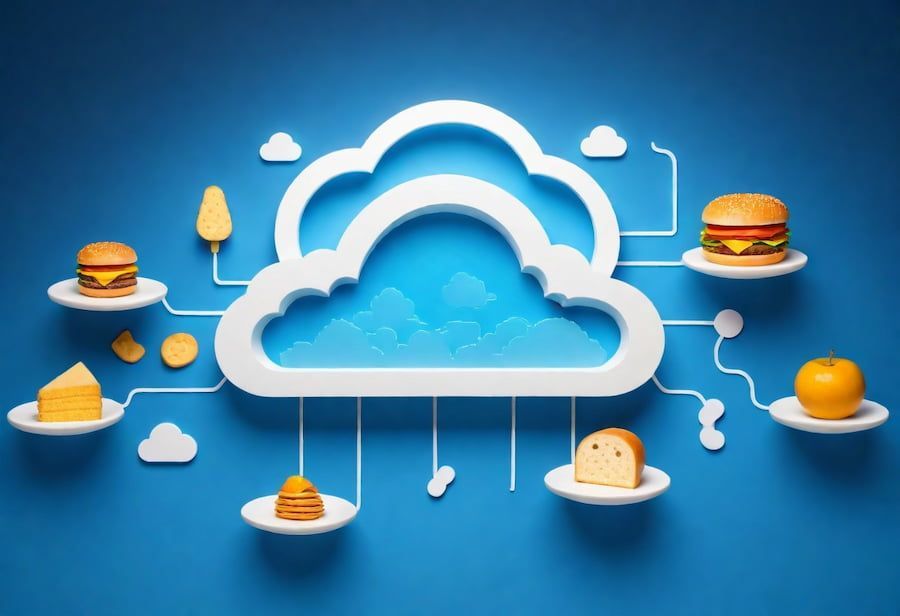Food cloud systems are digital platforms that use cloud computing technology to manage, monitor, and optimize food-related operations. These systems help businesses and institutions such as restaurants, supermarkets, supply chains, schools, and food banks improve how they track inventory, reduce waste, ensure food safety, and streamline logistics.
In essence, food cloud systems collect data from various sources (like sensors, apps, or manual inputs), store it in the cloud, and make it accessible in real time. With this data, decision-makers can analyze trends, predict shortages, automate compliance checks, and coordinate deliveries more efficiently.

This smart approach to food management is increasingly vital in today’s complex and globalized food network.
Why Smart Food Management Matters
Smart food management through cloud systems addresses several critical issues:
1. Food Waste Reduction
-
According to the United Nations, about 1.3 billion tons of food are wasted globally every year.
-
Cloud systems help track expiration dates, storage conditions, and inventory turnover, enabling early intervention to prevent spoilage.
2. Supply Chain Visibility
-
Cloud-based systems provide end-to-end visibility from farms to retail shelves.
-
This transparency is crucial for preventing bottlenecks, managing demand, and handling recalls quickly.
3. Food Safety Compliance
-
Monitoring temperature, hygiene, and storage standards in real-time reduces the risk of contamination.
-
Digital records make audits and inspections faster and more reliable.
4. Sustainability Goals
-
Efficient food management supports lower carbon emissions by reducing waste and optimizing transportation.
-
It helps institutions meet ESG (Environmental, Social, and Governance) goals.
5. Cost Efficiency
-
Businesses can save significantly on overstocking and waste disposal.
-
Labor time is reduced due to automation of manual tasks such as logging deliveries or checking inventory.
Recent Developments in Food Cloud Systems (2024–2025)
Several innovations and trends have emerged in the past year:
| Trend | Details |
|---|---|
| AI Integration | Systems like IBM Food Trust now use AI to predict supply-demand imbalances, improving efficiency. |
| Blockchain Adoption | In 2024, major retailers began using blockchain for traceability, ensuring product origin transparency. |
| IoT Devices Growth | Use of smart fridges, temperature sensors, and RFID tags grew by over 20% globally in 2024. |
| Mobile Access Expansion | More systems now offer full mobile access, allowing on-the-go monitoring. |
| Non-Profit Integration | Food banks and charities adopted cloud systems to better distribute surplus food and reduce hunger. |
Legal Framework and Policy Support
Regulatory frameworks are playing a key role in supporting or requiring smart food systems. Here are a few examples from around the world:
United States
-
FDA’s New Era of Smarter Food Safety (2020–2025): Encourages use of digital tools for traceability and outbreak prevention.
-
FSMA (Food Safety Modernization Act): Requires digital documentation and compliance for food safety.
European Union
-
Farm to Fork Strategy (2020–2030): Promotes digital innovation for sustainability and traceability in food systems.
-
General Food Law Regulation: Requires risk-based approaches and digital records for traceability.
India
-
FSSAI Guidelines: The Food Safety and Standards Authority of India is piloting smart food traceability and compliance systems.
-
Digital India Initiative: Encourages cloud adoption across industries, including agriculture and food sectors.
These laws aim to enhance food quality, traceability, and reduce losses from mismanagement.
Helpful Tools and Resources
Various digital solutions and platforms help organizations implement food cloud systems. Here’s a list of commonly used tools and resources:
Popular Cloud Platforms
-
IBM Food Trust – Blockchain and AI-powered food traceability.
-
Google Cloud for Food Industry – Scalable storage and analytics tools for food chains.
-
SAP Intelligent Food Network – Focuses on transparency, traceability, and compliance.
Inventory and Waste Management Tools
-
Leanpath – Tracks food waste and suggests reduction strategies.
-
Winnow – Uses AI to monitor kitchen waste in hospitality.
-
KitchenCUT – Provides cloud-based stock control and food costing.
Government & Nonprofit Resources
-
UN FAO’s Food Loss Index – Global data and guidance on reducing loss.
-
WRAP (UK) – Offers food waste reduction strategies and reports.
-
FSSAI’s Food Safety Connect App (India) – Compliance and reporting tool for small vendors.
Templates & APIs
-
Temperature log templates
-
Shelf-life trackers
-
API integration for POS and warehouse systems
Using these tools helps reduce manual errors, optimize processes, and ensure compliance with food laws.
Frequently Asked Questions (FAQs)
Q1: What types of organizations use food cloud systems?
A: Food cloud systems are used by restaurants, grocery chains, warehouses, food delivery services, schools, hospitals, food banks, and even farms.
Q2: How do food cloud systems improve food safety?
A: They track storage conditions like temperature and humidity in real time, alerting users before spoilage occurs. This ensures compliance with safety regulations and reduces the risk of foodborne illnesses.
Q3: Are food cloud systems expensive to implement?
A: Costs vary based on features and scale. Many platforms offer subscription models or customized pricing. For small businesses, basic solutions can be quite affordable.
Q4: Can food cloud systems work offline?
A: While core functions require internet access, many tools offer offline data collection and syncing once a connection is restored.
Q5: How do these systems help reduce food waste?
A: They monitor expiration dates, predict demand trends, and track inventory in real time, which helps users take timely actions like adjusting orders or repurposing surplus.
Final Thoughts
Food cloud systems represent a significant advancement in how we manage and distribute food. By connecting data across the food chain from farm to fork these systems help reduce waste, ensure safety, and improve efficiency. Their relevance is growing in the face of rising global food demand, sustainability goals, and stricter compliance requirements.
As governments encourage digital transformation in agriculture and food industries, and as technology becomes more accessible, we can expect even broader adoption of food cloud systems in the years ahead.
